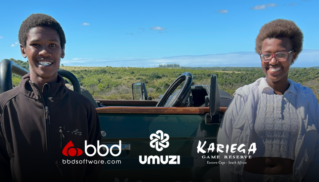
African fintechs are ‘doing it for themselves’. Three leading members of its fintech ecosystem – Matthew Barnard, Gwera Kiwana and Matteo Rizzi – talk about what that means for them… and the rest of the world.
“Everything is a fintech in Africa,” observes Matteo Rizzi. From a city with more preloaded bus passes than bank accounts, to drought monitors that compensate farmers for crop losses, it’s the fastest-growing startup community on the continent – and the sector’s revenues are predicted to keep on growing… by a factor of eight to $30billion by 2025, according to McKinsey. Investment is significantly up too – bucking the worldwide nervousness shown by Venture Capitals (VC) towards tech in other markets. Investment in Africa’s tech ecosystem went up by 8% in 2022, hitting a new record of $ 6.5 billion. The US, by comparison, saw deal values down by 30%.
But perhaps the most significant shift in the local fintech landscape is that its African innovators, companies and backers developing solutions for themselves now. The rest of the world can look on with humility and respect. It might even learn something from this grassroots approach to innovation. That’s not to say the African model of fintech entrepreneurship is without its challenges. As Rizzi, a financial services entrepreneur and co-founder of FTS Group, a consultancy that builds fintech ecosystems, points out, a sector largely dominated by locally made solutions, tailored to domestic consumer needs means a frustrating lack of interoperability.
“Each specific ecosystem in Africa, for historical and technical reasons, has different customer demands that drive financial inclusion,” explains Rizzi. “It’s very uneven – from a country like Mozambique, which is 60 million people, but doesn’t have Uber, to a country like Angola, where there is not yet even a digital bank.” The hyper-focus on understanding local challenges and coming up with imaginative ways to solve them might be a lesson in customer centricity, but it creates challenges of its own for businesses that want to scale.
“We’re seeing a wave of ‘by us, for us’ products, services and solutions being built – rather than Global North companies coming to Africa and building things that people just don’t want, or won’t use.” – Gwera Kiwana, MFS Africa
Africa is a massive continent, with 54 different countries and at least 75 languages spoken by 1.4 billion people. It’s this size and diversity that has led to both a highly innovative and highly fragmented market, exacerbated by infrastructure challenges across the continent. Varying levels of digital maturity mean that places with more advanced financial systems and infrastructure, such as Nigeria and South Africa, are better placed to accelerate and scale fintech innovation than others. That said, there’s a local proverb that says, “the sound of the drum depends on the drummer’; and the noise coming out of this fintech ecosystem is both loud and distinctly different to what investors up until now have come to expect.
“Previously, companies from Europe or America were coming in and trying to impose European and American solutions onto Africa,” says Matthew Barnard, BBD’s executive director. “The tide had changed. Now Africans, and African countries, are developing solutions that are very specific for them. What I’m seeing is a hell of a lot of innovation happening; people now have access to technology, access to the internet, access to the public cloud [and] are able to innovate faster and faster.”
But then they come up against that lack of infrastructure – and it’s particularly apparent in the payments space. “If we can describe payments in Europe and North America as 1% finished, in Africa is 0.01%,” says Gwera Kiwana, who previously worked at UK Neobank Monzo and fintech consultancy 11:FS. She’s now founder in residence for crypto at MFS Africa, the largest payments hub in the region, whose network integrates more than 400 million mobile money accounts across a least 35 African countries.
“There are a lot of really cool companies and people building really thoughtful products and services,” Kiwana says. “But it’s the companies connecting these markets to one another that are doing a lot of the heavy lifting.”
While there are some organisations, as with the Gates Foundations Mojaloop initiative, that are attempting to build a ubiquitous payments infrastructure for Africa, finding scalable solutions remains very difficult. That has influenced how the African fintech market works – which is notably not based on the traditional payments infrastructure that you might find in the West.
Africa now accounts for 70% of the world’s $1 trillion mobile money value, with the most globally renowned African fintech being Kenya’s mobile phone-based money transfer service M-Pesa, which is used primarily for sending, withdrawing and depositing cash.
Cash is still very much king, accounting for 90% of all transactions, and growing in use in many territories; only 48% of the population was expected to have a bank account by the end of 2022. So, while ‘embedded finance’ for instance, is a driver in Western markets, where the majority of people have access to bank accounts, in cash-dominated Africa you can’t base a product on this assumption as the underlying infrastructure often isn’t there in the first place.
“Because we’re a continent that’s really working on cash, what we want is a cash equivalent that’s digital. We’re not really looking for bank accounts,” says Kiwana. An example of the kind of solutions people instead find most useful in this context, Rizzi cites Tap&Go in the Rwandan capital of Kigali – a public transport payment card similar to London’s Oyster network. “There are one million of them while the total number of bank cards in Kigali is 250 000 – so there is one transportation [system] that releases four times the number of bank accounts in the city,” Rizzi notes. It’s another example of how ‘in Africa, everything is a fintech’. “The moment that this startup gets permission to use these cards to do other transactions – not just pay for buses – it becomes the first fintech in the country. The customer demand in Africa is driven not by financial services, but by day-to-day life,” he says.
Gozem is another example – a super app that’s operational across French-speaking West and Central Africa, described by Rizzi as a cross between Uber for motorbikes and a delivery company. “They see themselves as being a fintech,’ he observes. “Why? Because they’re financing vehicles for users, taking digital payments, and cross-selling insurance services.” Rizzi points to another – an agritech in Senegal that uses data from satellite images to figure out where the water is and where fields need it. It quickly became a fintech company by cross-selling insurance to local farmers, based on the data it collected. The commonality between these is that they are domestically built products, fulfilling local consumer needs and leveraging local infrastructure – often in areas with very low financial inclusion rates. Kiwana suggests this trend is likely to continue.
“We’re seeing a wave of ‘by us, for us’ products, services and solutions being built, rather than taking tons of venture capital money, and large North American and Global North companies coming to Africa and building things that people just don’t want, or won’t use,” she says. What Kiwana calls ‘tourism fintech’ – large global companies and banks entering the continent and trying to innovate with a top-down approach – is over. The explosion in grassroots-based solutions has a distinct cultural fit – many, for example, are reliant on agent networks such as Kenyan-based M-Pesa, Nigerian startup Baxi, which was acquired by MFS Africa in 2021, and Lagos-based app Paga.
Agent networks play a particularly important role in Africa as they enable financial services providers to reach more customers, including those offline, by using pre-existing infrastructure and physical outlets for the delivery of services. “Despite things being faster and a lot more efficient, there’s still quite a lot of the culture involved… [financial services] are not monolithic at all. They’re a lot more community-centric and a lot more human interaction is required,’ Kiwana explains.
“There’s more quick data, easily accessible, in Africa than in other parts of the world, which is why instant lending is something that mainly exists on the continent.” – Matteo Rizzi, FTS Group
“In low-trust economies and societies like Nigeria – where there are a lot of checks and balances, and a lot of things you need to do to get a bank account in the first place – having your money live in a mobile money wallet and seeing a real person (an agent) who’s able to help you take your money out in cash, deposit it or move it around, is really important.” And yet, while mobile-based services such as M-Pesa are essentially there to move cash, their mass adoption and the frequency with which they are used means that paradoxically they create an enormous digital footprint, says Rizzi. “There is more quick data, easily accessible, in Africa than in other part of the world, which is why instant lending, for example, based on mobile data, is something that mainly exists on the continent,” he observes.
Rizzi cites the example of Tala, which offers lending services in Kenya (as well as India, Mexico and the Philippines), and has so far disbursed more than $2 billion worth of small and instant loans via phone. “There’s nothing at this scale possible in Western economies, simply because the way of interacting with the phone, and the development of the applications based on that accurate information, isn’t comparable,” says Rizzi. Indeed, it’s prompting many on the continent to look elsewhere for inspiration when it comes to revolutionising their financial services.
“In South Africa, specifically, many fintechs are starting to take a lead from what is being seen in Asia, in terms of embedding multiple applications within a single app and creating multiple services for clients,” says Barnard. That’s presumably a nod to services such as China’s Alipay and Southeast Asian super app Grab. “So, they’re not really taking a European / North American model. It’s the developing world taking the lead from other developing countries – whether that’s South America or Asia. Applying that thinking is probably more appropriate to the markets we find ourselves in.”
Barnard firmly believes that the African experience has much to teach the West, so he’s developing a pipeline, taking knowledge and technology into Europe. Necessity is the mother of invention, so they say, and he believes there is a lot to learn from innovation that’s based on need amid scarce resources and not pumped with VC funding.
“Traditionally services and products from Europe have been flowing into Africa; my job is to get things flowing the other way.” – Matthew Barnard, BBD
It’s an initiative that appears to be working, too. By applying technology and approaches that BBD has used with its African clients, the company managed to help a London-based small financial services firm save 50% of its back-office operating costs within 18 months. In another indication that the tables are turning, MFS Africa acquired a US paytech last year in a deal worth $34 million. Oklahoma-based Global Technology Partners (GTP) is the biggest processor of prepaid cards in Africa. Speaking at the time of the acquisition, the founder and CEO of MFS Africa, Dare Okoudjou, described it as a “momentous milestone for us and Africa’s tech ecosystem on many levels”, adding: “It’s something of a first for an African tech company to acquire a US tech company of GP size and stature”. It takes MFS Africa a step closer to addressing that infrastructure problem by joining up the payments dots in Africa, allowing it to accelerate card connectivity to mobile money users and other fintech companies operating across the continent. Kigali hosts the inaugural Inclusive Fintech Forum in partnership with the Monetary Authority of Singapore, this June, demonstrating that the sector is ready and willing to share its lessons with the wider world.
That drumbeat is growing louder and many in North America and Europe would do well to listen.
Click here to watch the full interview.
As published in The Fintech Magazine, Issue #27



